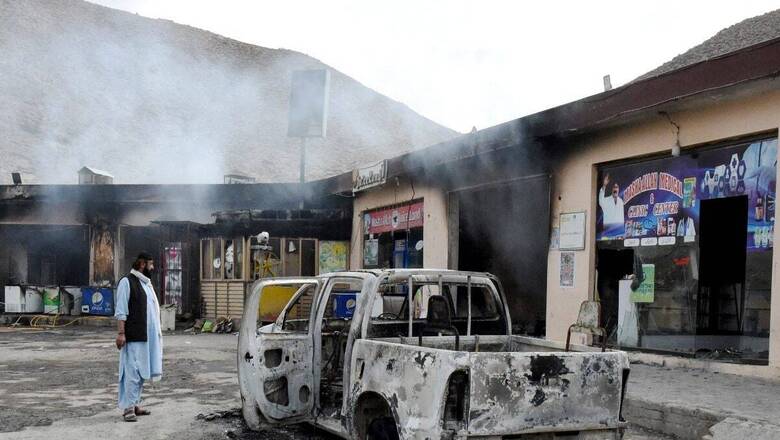
views
On the night of January 29, at 9 pm, the urban landscape of Mach in the Bolan district of Balochistan resonated with a powerful explosion, its auditory impact extending across several kilometres into the surrounding areas, encompassing the entirety of the city. The series of explosions and gunfire endured over the subsequent 48 hours. Just thirty minutes after the initial event, Jeeyand Baloch, the designated spokesperson for the Baloch Liberation Army (BLA), officially confirmed this operation stating, “The initiation of Operation Dara-e-Bolan by the BLA has been declared.”
Jeeyand Baloch cautioned the Baloch citizenry to exercise restraint, advocating for indoor seclusion and discouraging travel to urban locales. This cautionary guidance explicitly acknowledged the participatory involvement of BLA’s Majeed Brigade, Special Tactical Operations Squad (STOS), Fateh Squad, and Intelligence Wing in the unfolding operation. These intricate and intense offensive manoeuvres mark a distinctive phase in the Balochistan freedom movement, prompting certain analysts to classify it as a seminal historical episode within the broader scope of Baloch history.
The Baloch Liberation Army orchestrated Operation Dara-e-Bolan, a complex and historically significant offensive in Balochistan comprising 385 ‘freedom fighters’. The operation witnessed the active involvement of key BLA units, including the death squad Majeed Brigade, boasting a contingent of 12 members, along with the participation of BLA’s Special Tactical Operations Squad and Fateh Squad. The BLA’s attack commenced with a suicide bomber from the Majeed Brigade detonating a vehicle laden with explosives at the Pakistani forces’ headquarters. The assailant, subsequently disclosed as Farooq Syed, alias Chakar, was part of the meticulous planning and execution involved in this attack. Following the detonation, Majeed Brigade members initiated the assault, with other specialised units launching simultaneous attacks on military checkpoints, police stations, and various installations.
The strategic prowess of BLA fighters manifested as they assumed control over pivotal junctures such as the central highway, railway stations, and police stations, all while strategically deploying explosive materials to disrupt railway tracks. This operation marked a watershed moment, representing the inaugural instance of a Baloch pro-independence organisation employing a conventional military-style offensive. The city of Mach, strategically positioned within an 80-kilometre radius, fell under BLA control for an extensive duration of 46 hours. Noteworthy in this operation was the skillful utilisation of modern weaponry by Baloch fighters, including rockets and DShKs, colloquially known as Dashakka, heavy anti-aircraft machine guns that proved instrumental in neutralising military helicopters.
The BLA, cognizant of the sacrifices made, confirmed the demise of 13 of its members during the operation, comprising 12 from the Majeed Brigade and one from the Fateh Squad. Simultaneously, the organisation boldly claimed responsibility for the fatalities of 78 Pakistani troops, encompassing regular army personnel, paramilitary Frontier Corps, and elite commandos from the Special Services Group (SSG). In a multifaceted display of strategic acumen, BLA fighters not only retained control over the military headquarters but also systematically targeted military convoys arriving to aid beleaguered forces. The main highway outside the city became a theatre of conflict, with the BLA tactically engaging death squad members—local militias enjoying patronage from the Pakistan army—thus adding a layer of complexity to the operation.
Throughout Operation Dara-e-Bolan, there was a discernible fluctuation in the Pakistani government’s posture, revealing a vulnerability in the perceived strength of the Pakistan Army. The Information Minister of Balochistan, Jan Achakzai, issued a series of statements during this period, each reflecting a degree of uncertainty. Despite these official communications, public attention remained riveted to the communication channels of the Balochistan Liberation Army on platforms such as Telegram and WhatsApp. Notably, the information minister, in a sequence of statements over the subsequent three days, displayed a palpable sense of unease. Initially, his prompt retraction, a mere half-hour after the attack, conveyed a lack of coherent information, stating, “We have received information about a few rocket firings in the mountainous areas.”
Subsequently, the minister revised his position, asserting, “In Mach, security forces have successfully thwarted three coordinated attacks carried out by militants associated with the Aslam Acho group. Militants have retreated, and our security forces are presently in pursuit.” Despite these reassurances, visual evidence provided by Mach residents continued to depict a precarious security situation. Concurrently, the BLA’s media channel disseminated content featuring auditory messages from fighters and videos showcasing BLA operatives in the area, underscoring a narrative that contradicted the official stance. This sequence of events contributed to a perception of weakness on the part of the Pakistan Army during the BLA attacks.
In recent times, the Baloch Liberation Army and allied pro-independence factions have undertaken strategic recalibrations in their operational methodologies, notably involving the capture of Pakistani military installations, apprehension of active-duty military officers, and intelligence agency personnel. A seminal event in this trajectory is Operation Dara-e-Bolan, wherein four concomitant BLA units orchestrated the takeover of an urban centre, thereby attesting to the adeptness of the group’s combatants. As articulated by BLA spokesperson in an official statement, the overarching objective of Operation Dara-e-Bolan was to exemplify to the Baloch populace the organisational efficacy of their national army, the BLA, in effecting the liberation of a city from the influence of Pakistan and sustaining control over the territory for an uninterrupted period of two days.
This strategic pivot in the Baloch freedom struggle, marked by a shift from mountainous terrains to urban landscapes, is epitomised by the intensity of the aforementioned operation and the protracted occupation of the urban enclave. This development portends a potential augmentation of the Balochistan freedom movement within urban domains in the forthcoming epoch. A historical contextualisation reveals the BLA’s track record of successful operations, including the seizure of Chinese Consulates, the High-Security Zone in Gwadar, and intelligence-centric endeavours in Turbat city. However, Operation Dara-e-Bolan, distinguished by the coordinated engagement of four distinct units, serves to underscore the operational prowess of BLA operatives and heralds a departure from antecedent attack modalities.
Over an extended temporal continuum, the youthful demographic of Balochistan has endured consistent persecution and degradation at the hands of the Pakistani military apparatus. Consequently, this prolonged maltreatment has inherently culminated in the validation and acknowledgement of the Baloch Liberation Army (BLA) within the socio-political landscape of Balochistan.
The writer is an author and columnist and has written several books. His X handle is @ArunAnandLive. Views expressed in the above piece are personal and solely that of the author. They do not necessarily reflect News18’s views.




















Comments
0 comment